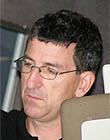|
|
 
|
|
Author
|
Topic: 6 Track Magnetic vs 6 Track Digital
|
|
|
|
|
|
|
|
|
|
|
|
|
|
|
|
|
|
|
|
|
|
|
|
|
|
|
Bobby Henderson
"Ask me about Trajan."

Posts: 10973
From: Lawton, OK, USA
Registered: Apr 2001
|
 posted 12-29-2010 12:10 AM
posted 12-29-2010 12:10 AM




It's not so easy to say which type of audio (analog or digital) is better. Lots of variables are involved.
Using proper recording and mastering techniques in conjunction with the best of what's currently available in technology, "digital" can handily beat the quality levels of analog.
Unfortunately, the best techniques are often not used when recording and mastering digital audio.
Movie soundtracks are often put together pretty fast. The music score, ADR, sound effects, etc. are among the very last elements produced in a movie production. Quality is going to be only so good when things are done in a hurry. Lots of canned audio effects of varying ages and quality levels are used.
With popular music the quality bar is all over the place. Most rock and dance pop music is horribly mastered. The high end of the wave form is often badly clipped and the remaining wave form dynamically compressed so everything sounds loud and punchy rather than natural and clean. This isn't a fault of digital technology. Rather it's a fault of listener ignorance and the tendency of record producers to cater to that ignorance.
I can play an old CD carefully mastered from analog material, such as the 24K gold "Ultradisc II" version of Pink Floyd's Dark Side of the Moon. None of that audio is clipped. The wave form is preserved, even though it's only in standard music CD resolution. That disc plays at a very noticeably lower volume level than just about any newer music disc I own.
Digital has weaknesses in areas like analog to digital and digital to analog signal conversion. A/D and D/A converters have greatly improved over the years. The live audio is "analog" but must be converted into digital data at some point. When the audio is played back through your speakers it has to be converted back into an analog signal so it can be amplified for the speakers.
Analog has its own weaknesses. The tape width and recording speed used are big quality factors. Lots of other variables play a part. Analog tape can stretch, "sweat," shed or just wear out over time.
Basically neither system is perfect. Both analog and digital audio can sound exceptional or horrible.
With either digital or analog audio sources, the sound system itself plays a giant part in determining audio quality.
quote: Mark J. Marshall
SR has a wider frequency range and a wider dynamic range than digital.
Dolby SR magnetic has a wider dynamic range than 16-bit digital. But it doesn't have a greater dynamic range than 24-bit digital.
Bit word length is one quality factor with digital. Sample rate is another.
Music CD supports 16-bit depth with 44,100 16-bit samples per second. Most movie discs have audio running at 48,000 samples per second, often in 20-bit or 24-bit sample depths. Blu-ray commonly delivers lossless 24/48 audio but can also deliver up to 8 channels of 24-bit 96kHz audio or even 2 channles of 24-bit 192kHz audio.
The combination of increased bit depth and sample rates can smooth out any of the harshness associated with digital audio. The audio creators just have to use the technology properly. Many of them aren't. They're treating digital audio the way many wannabe graphic designers are treating their fonts: disgraceful abuse.
quote: Mark J. Marshall
I think the only 70mm six track SR print was Star Trek 4, but I might be wrong.
Star Trek IV: The Voyage Home was the first movie to use 70mm Dolby SR prints. But it wasn't the only 70mm SR release. I'm pretty sure the 1989 restored version of Lawrence of Arabia had 70mm SR prints -at least it was advertised that way in New York. Indiana Jones & the Last Crusade had 70mm Dolby SR prints; I saw the one that played Loews Astor Plaza in Times Square. I thought Born on the Fourth of July sounded pretty damned good at the Ziegfeld theater. There's at least a couple dozen or so other movies released with 70mm Dolby SR prints between 1987 and into the 1990s.
| IP: Logged
|
|
|
|
|
|
All times are Central (GMT -6:00)
|
This topic comprises 11 pages: 1 2 3 4 ... 9 10 11
|
Powered by Infopop Corporation
UBB.classicTM
6.3.1.2
The Film-Tech Forums are designed for various members related to the cinema industry to express their opinions, viewpoints and testimonials on various products, services and events based upon speculation, personal knowledge and factual information through use, therefore all views represented here allow no liability upon the publishers of this web site and the owners of said views assume no liability for any ill will resulting from these postings. The posts made here are for educational as well as entertainment purposes and as such anyone viewing this portion of the website must accept these views as statements of the author of that opinion
and agrees to release the authors from any and all liability.
|

 Home
Home
 Products
Products
 Store
Store
 Forum
Forum
 Warehouse
Warehouse
 Contact Us
Contact Us




 Printer-friendly view of this topic
Printer-friendly view of this topic












![[Wink]](wink.gif)







